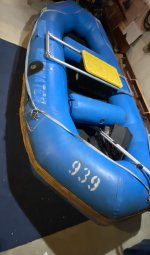I am interested in getting a one man inflatable fishing vessel, for example a Watermaster Grizzly or similar product.
While I have many, many hours of boating /canoeing / kayaking experience on both rivers and lakes, I have never used an inflatable raft outside of a pool. I have a few questions for those of you that use them.
1- Is there considerable concern for putting a hole in such a product and becoming stranded on the river or sinking in the middle of a lake?
2- Is it conceivable to be able to repair and inflate the raft in the field if such a situation occurs so you can go on with your adventure, or does damage usually ruin the day?
3- Are these things built like brick shithouses so it would take a nuke to put a hole in them, or do they end up consisting of more patch material than original rubber with some moderate use?
Thanks.
I fished out of a canoe for 40+ years. When I got into my mid-50s my back decided canoes are not great. In the Summer of 2020 I bought a Flycraft Stealth X I run it on the upper D, N. Branch Susky, local lakes, smaller creek, and in the salt (SW FL, harbors and backwaters). I love it!
Here are my answers to your questions + some addl. commentary.
1- Not "considerable", just reasonable caution. My raft has 5 chambers: 4 quadrants of the main raft + floor (inflatable SUP). No worries about sinking it.
2- In my boat bag I carry the manufacturer's repair kit + Gorilla Waterproof Patch & Seal Tape 4" x 10'. No worries there.
3- They are not bomb-proof, but as stated above, they are VERY durable. Example: at the end of year 1, I saw some exposed threads near the front of both pontoons. These appeared mostly due to some dragging on concrete and asphalt while loading, unloading, etc. I send photos via email to Flycraft. They said I had not worn through layer 1 of 6 (or something like that. They have, essentially, a skid plate of heavy butyl (or something like that. When that wear eventually is a concern, I can get a kit with new material and chemicals to build up more layers as needed. It seems like that's years away from being necessary. The only real concern is hitting something like sunken rebar while going through faster water.
Something that makes sense but I did not consider (shame on me) is Bolye's Law. Basically, your inflatable will seem to deflate as temperatures drop and inflate as they rise. You need to adjust the internal pressure accordingly. For example, let's say you fished early AM in the Summer and air temps were 65. You pump up the bladders to the recommended pressures. You finish your fishing at noon. Air temps are now in the mid-80s. Now your bladders are rock hard (overinflated). No good, too much stress on seems. The inverse is true. So, you deflate each bladder a bit to compensate for the higher air temps and decide to fish into evening, load up, and come home. The next morning it's down to 65 degrees again. Now your boat looks like it's half-deflated. Did you puncture something? Nope, Boyle's Law.
Another thing that I learned is that these things are like leaves on the water when the wind blows.
BTW, I would stay away from Stealthcraft. My buddy had one that developed a problem due to a flaw + poor advice from the owner of Stealthcraft. Long story. Bottom line: They had difficult communication, did a poor job of standing behind their product, and the owner was consistently rude.
Flycraft, on the other hand, had been great to deal with.







